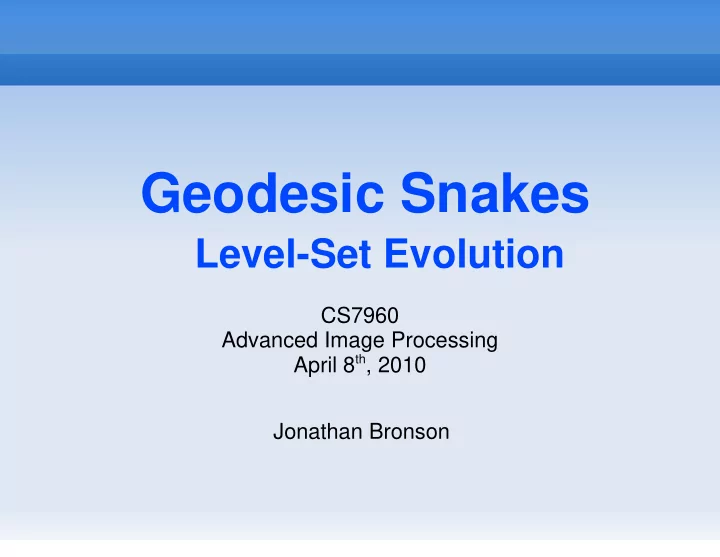

Geodesic Snakes Level-Set Evolution CS7960 Advanced Image Processing April 8 th , 2010 Jonathan Bronson
Content Motivation Implicit Contour Formulation Hypersurface Embedding Examples Conclusions
Motivation Drawbacks of previous Snake formulations: Explicit Representation Parameterization / Reparameterization issues Approximating Discrete Derivatives Fixed Topology Extention to 3D very complex (active meshes)
Motivation New Approach: Embed contour in higher order surface Implicit Representation Insensitive to Topology Easily extends to 3D
Mathematical Framework : Speed dC d t = N N : Normal dC :Curvature d t = N
Mathematical Framework Combining terms simple: d C d t = N Still want: Ability to slow/stop on edges/lines/etc Image force term d C d t = g I N Where have we seen this before?
Mathematical Framework Anisotropic Diffusion (Perona & Malik) Use gradient magnitude for diffusion speed 1 − ∥ I ∥ ∇ 2 g I = g I = e 1 ∥ I ∥ ∇ 2 (Quadratic) (Exponential)
Mathematical Formulation What if we overshoot? Want to pull toward edges ∂ C N − ∇ g I N ∂ t = g I ⋅ N Advection Term
Embedding Contour C(s,t) into Surface u(x,t)
Embedding u ∈ℜ 3 Embedding function: u x ,t C ∈ℜ 2 Contour: C s ,t u C ,t = 0 (Zero level-set) u x ,t C s ,t
Embedding
Embedding Formulation How does surface vary over time? u C t ,t = 0 ∂ t ∂ t ∂ t ∂ t dt u C t ,t =∂ u ∂ C ∂ x ∂ C ∂ y ∂ C ∂ z d Chain Rule ∂ x ∂ y ∂ z dt u C t ,t =∂ u N = −∇ u d ∂ t ∇ u ⋅ dC dC d t = ∣ ∇ u ∣ dt ∇ u ∇ u dt u C t ,t =∂ u = ∣ ∇ u ∣ d ∂ t − ∣ ∇ u ∣ = 0 ∣ ∇ u ∣ ∂ u ∂ t = ∣ ∇ u ∣ Hamilton-Jacobi Equation for certain speeds
Interpretation
Summary Implicit Solution Solvable using PDE's (stable) Parameterization Free Seamlessly handles Topological Changes Extends to 3D in Straightfoward Manner Common Implementations Fast Marching Method Fast Iterative Method
Examples (www.cs.bris.ac.uk)
Recommend
More recommend